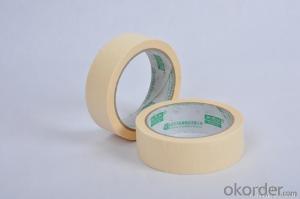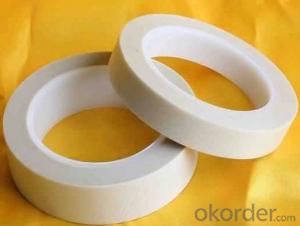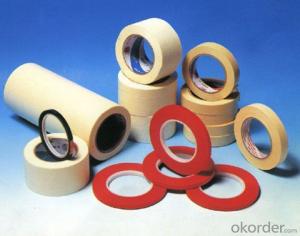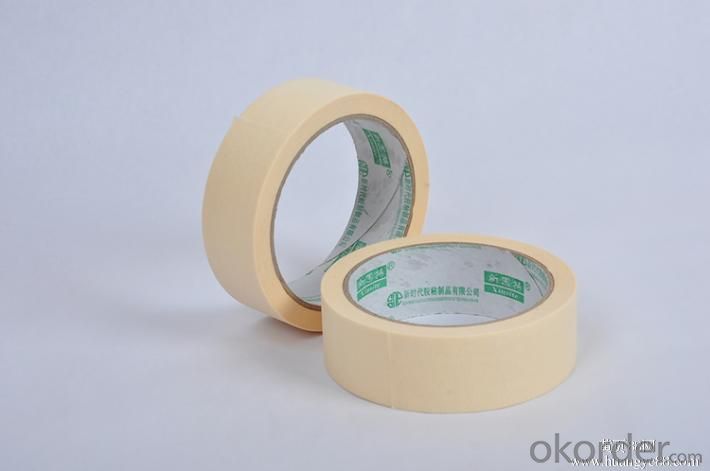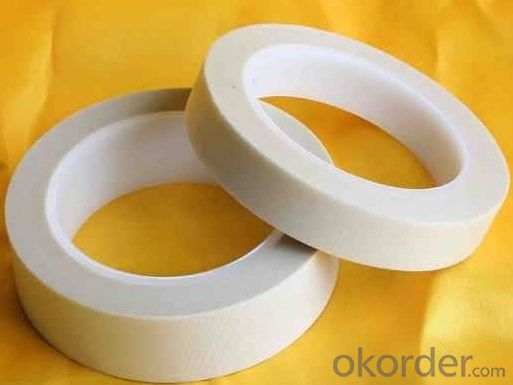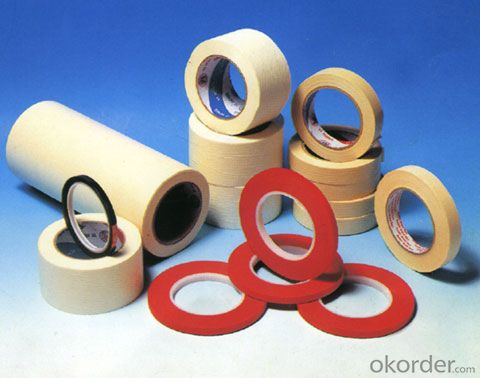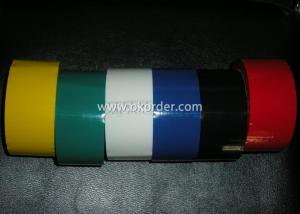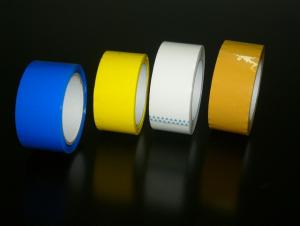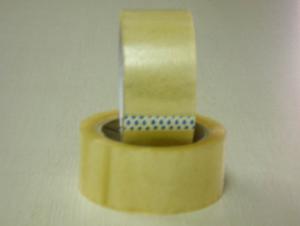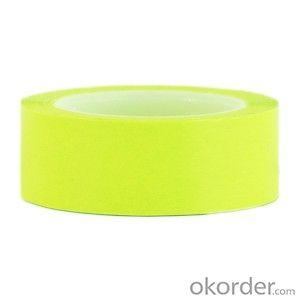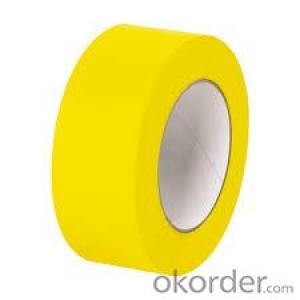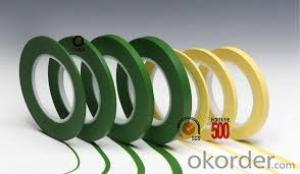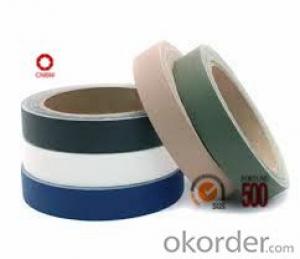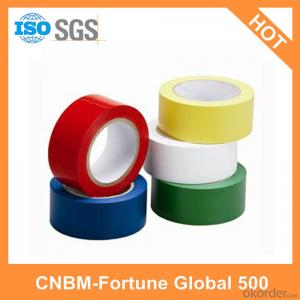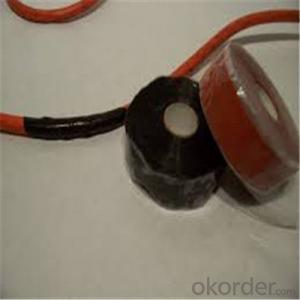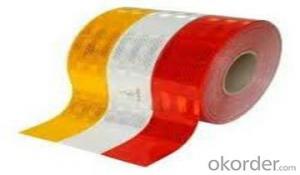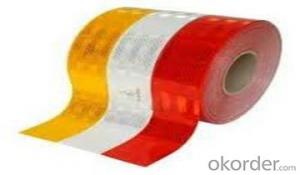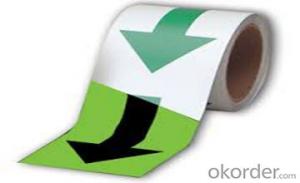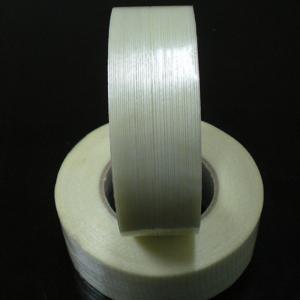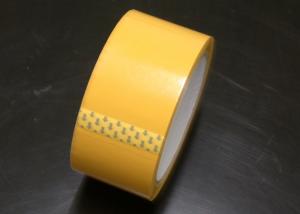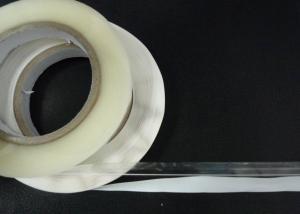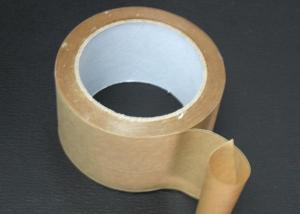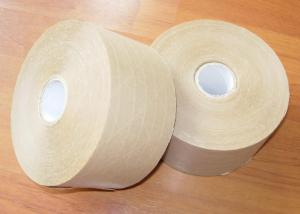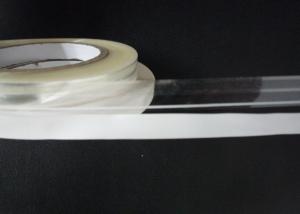Bear Packaging Tape - Silicon Rubber Adhesive Masking Paper Tape
- Loading Port:
- Shanghai
- Payment Terms:
- TT OR LC
- Min Order Qty:
- 5000 roll
- Supply Capability:
- 10000000 roll/month
OKorder Service Pledge
OKorder Financial Service
You Might Also Like
General Information of Silicon Rubber Adhesive Masking Tape, Masking Paper Tape
1. PACKING:
Core I.D.: 3” (76mm +/- 1)
Jumbo Roll:990mm x 1800m; 80 rolls/20' without pallets
Cut Roll: As per customer’s requirements; fistly several rolls shrink together, then certain quantities into a carton, finally be loaded into container with or without pallets.
2. Application:
Interior paint masking, silk screening, Light duty packaging, bundling, holding, splicing &Tabbing, painting autos, boats, and Electrical industry.
3. Temperature resistance: 60-70°C
4. Colors available: White, light yellow, yellow, blue, black, red, green etc.
5. We could supply OEM service such as core printing with customer's LOGO; round label with design of customers etc.
6. Special requirements will be satisfied after communications
Technical Data of Silicon Rubber Adhesive Masking Tape, Masking Paper Tape
CONSTRUCTION:
Carrier: Crepe Paper
Adhesive: Rubber based adhesive
TYPICAL PHYSICAL PROPERTIES of Silicon Rubber Adhesive Masking Tape, Masking Paper Tape
Total Thickness (adhesives + carrier): 145 +/- 5 micron
Initial Tack (steel ball): 8 #
180 Peel Adhesion (to steel): 6.5 +/- 0.5 N/25mm
Holding Power: 4 hrs
Tensile Strength: 65 +/- 5 N/25mm
Elongation: 10%
Temperature resistance: 60-70°C
Remarks of Silicon Rubber Adhesive Masking Tape, Masking Paper Tape
The data above are typical results and subject to change without notice.
Tolerance: Weight and Thickness: ±10%; Width: ±3mm;
Length: Cut Roll & Log Roll ±0.3m, Jumbo Roll ±0.5%.
The products should be stored at room temperature and be kept away wet and/or heat source.
It is essential, as with all pressure-sensitive tapes, that the surface to which the tape is applied must be clean, dry, and free of grease and oil.
The users should take test and do trial-application on the above products before coming into application so as to witness and ensure suitability for their special purpose and technique.
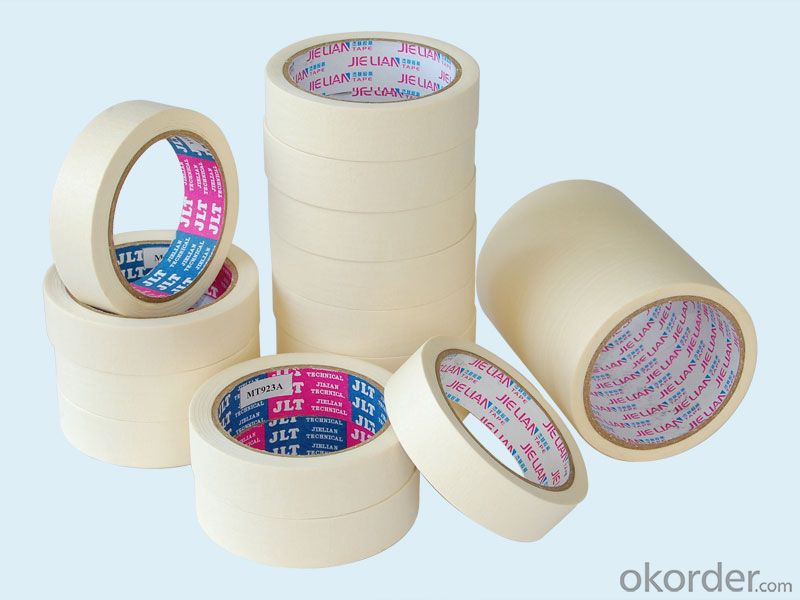
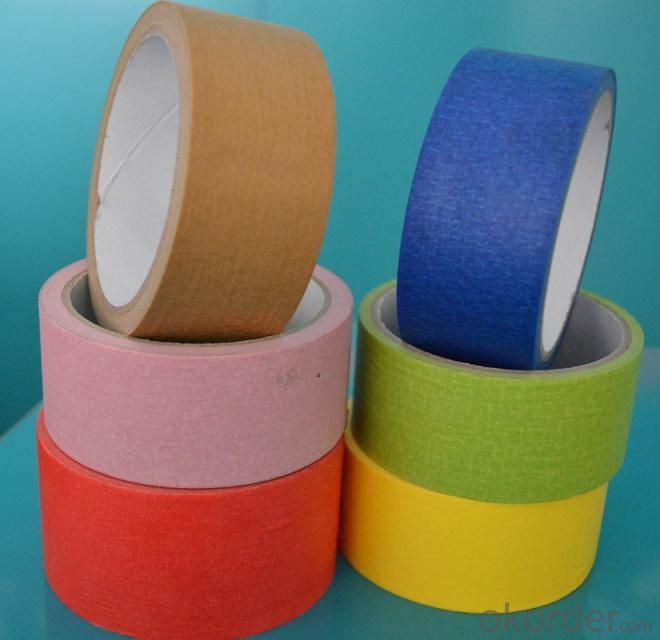
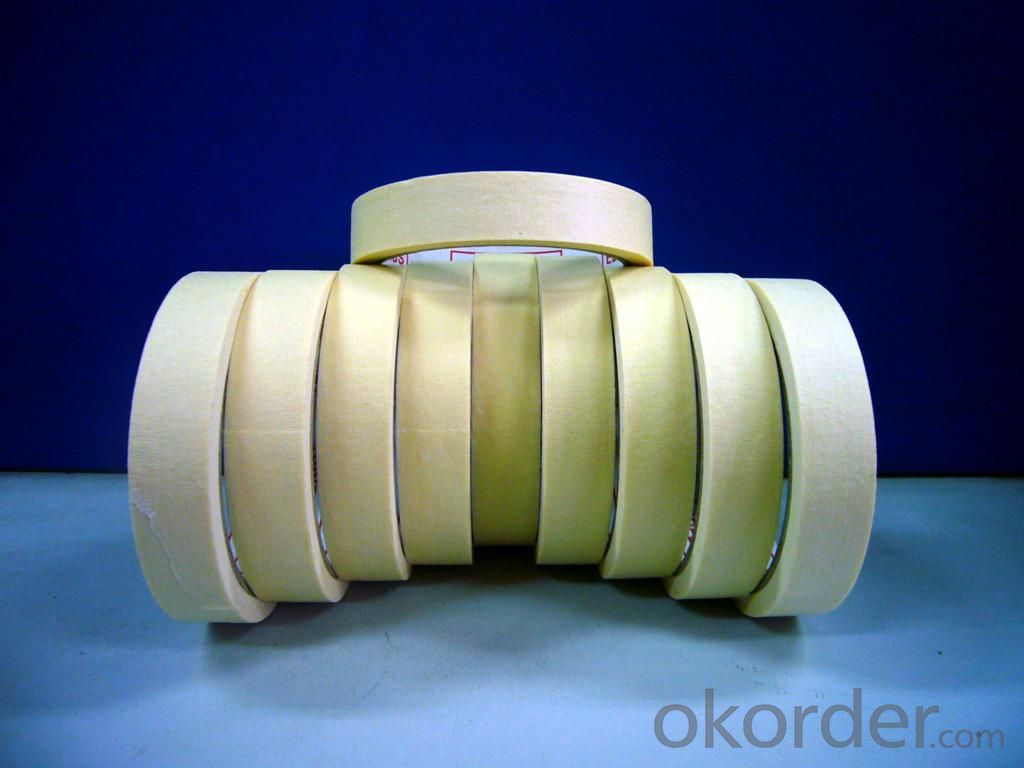
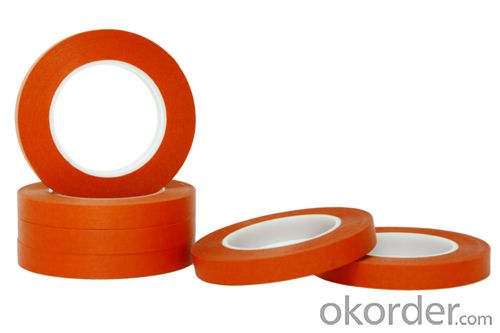
- Q: Can packaging tape be used for sealing metal containers or boxes?
- Packaging tape is ideal for sealing metal containers or boxes due to its strong adhesive properties. This type of tape is specially manufactured to adhere effectively to various surfaces, including metal. By using packaging tape, you can ensure a secure and reliable seal, providing protection for the contents of the metal container or box during storage or transportation, and preventing any unwanted opening or damage. Nevertheless, it is crucial to guarantee that the surface of the metal container or box is clean and free from grease or dirt to achieve optimal adhesion. Moreover, in cases where the metal container or box will be exposed to extreme temperatures or harsh conditions, it is recommended to employ a tape specifically designed for those environments to ensure a more long-lasting seal.
- Q: What are the considerations for using packaging tape on fragile items like ceramics?
- Several important considerations should be kept in mind when using packaging tape on fragile items such as ceramics. To begin with, it is crucial to carefully select the appropriate type of packaging tape. It is advisable to look for tape that is specifically designed for fragile items or delicate surfaces. This type of tape generally possesses features such as gentle adhesive and high tensile strength, which can help prevent damage or residue on the ceramics. Handling the ceramics with care during the application of the tape is also of great importance. It is important to avoid applying excessive pressure or force that could potentially result in cracking or breaking. Additionally, ensuring that the surface of the ceramics is clean before applying the tape is essential for proper adhesion. Consideration should also be given to the amount of tape that should be used. While it is necessary to adequately secure the ceramics, using an excessive amount of tape can add unnecessary weight and potentially harm the fragile item. It is advisable to use just enough tape to securely hold the ceramics in place without putting excessive strain on them. Furthermore, it is recommended to use additional protective materials in conjunction with the packaging tape. Bubble wrap, foam sheets, or packing peanuts can provide extra cushioning and protect the ceramics from potential impact or vibrations during transit. Lastly, it is crucial to label the package as fragile to ensure that handlers are aware of its delicate contents. This can help minimize the risk of mishandling and provide an extra layer of caution during transportation. In conclusion, when using packaging tape on fragile items like ceramics, it is important to consider factors such as selecting the appropriate tape, handling the ceramics with care, using the right amount of tape, employing additional protective materials, and clearly labeling the package as fragile. By taking these factors into account, the safe transportation of fragile ceramics can be ensured.
- Q: Is packaging tape safe to use on photographs?
- No, packaging tape is not safe to use on photographs as it can leave adhesive residue, damage the surface, or cause discoloration over time. It is recommended to use archival-quality photo-safe tapes or alternative methods for preserving and protecting photographs.
- Q: Can packaging tape be used for outdoor applications?
- Yes, packaging tape can be used for outdoor applications. However, it is important to note that not all packaging tapes are designed for outdoor use. Regular packaging tapes may not withstand extreme weather conditions or exposure to UV rays, which can cause them to deteriorate or lose their adhesive properties. To ensure the durability and effectiveness of packaging tape for outdoor applications, it is recommended to use specialized outdoor or weather-resistant packaging tapes. These tapes are designed with stronger adhesives and materials that can withstand outdoor elements such as rain, heat, cold, and sunlight. They are often made with materials like acrylic or rubber, which provide better resistance to moisture, temperature changes, and UV rays. When selecting packaging tape for outdoor applications, it is important to consider the specific requirements of the intended use. This may include factors such as the duration of exposure to outdoor conditions, the weight and size of the package, and the surface to which the tape will be applied. By choosing the appropriate outdoor packaging tape, you can ensure that your packages remain securely sealed and protected, even in outdoor environments.
- Q: Can packaging tape be used for sealing glass or delicate items?
- Yes, packaging tape can be used for sealing glass or delicate items. However, it is important to handle the items with care and apply the tape gently to avoid any damage. It is recommended to use a cushioning material like bubble wrap or foam to provide additional protection before sealing with packaging tape.
- Q: What are the considerations for using packaging tape on textured surfaces?
- When using packaging tape on textured surfaces, there are a few considerations to keep in mind. Firstly, the texture of the surface can affect the adhesion of the tape. Textured surfaces typically have uneven or rough areas, which may make it difficult for the tape to adhere securely. It is important to choose a packaging tape that is specifically designed for textured surfaces. These tapes usually have a stronger adhesive that can better stick to uneven surfaces, ensuring that the tape will stay in place. Another consideration is the durability of the tape. Textured surfaces can be more abrasive than smooth surfaces, which can cause the tape to wear out more quickly. It is important to select a packaging tape that is made from a durable material, such as reinforced or heavy-duty tape. These types of tape are designed to withstand more wear and tear, providing a longer-lasting bond on textured surfaces. Additionally, the texture of the surface can also affect the appearance of the tape. Since textured surfaces are not smooth, the tape may not lay flat and can create air pockets or wrinkles. This can make the package look untidy or unprofessional. To improve the appearance, it may be necessary to use extra tape or apply it in a way that smooths out any unevenness. Lastly, it is important to consider the removal of the tape from textured surfaces. Textured surfaces can make it more difficult to remove the tape cleanly without leaving behind any residue. To prevent damage to the surface or any sticky residue, it is recommended to test the tape on a small, inconspicuous area before fully applying it. If the tape does leave residue, there are adhesive removers available that can help safely remove any remaining residue. In summary, when using packaging tape on textured surfaces, it is important to choose a tape specifically designed for uneven surfaces, select a durable tape that can withstand the texture, consider the appearance of the tape on the textured surface, and be cautious of any potential residue left behind when removing the tape.
- Q: Can packaging tape be used for sealing plastic containers with liquids?
- Yes, packaging tape can be used for sealing plastic containers with liquids. However, it is important to note that packaging tape is not specifically designed for this purpose and may not provide a completely secure seal. It is recommended to use tape that is specifically designed for sealing containers with liquids, such as waterproof or heavy-duty tape, to ensure a more reliable seal and prevent any potential leaks or spills.
- Q: How do I apply packaging tape evenly?
- Achieving an even application of packaging tape can be done by following the steps below: 1. Prioritize cleanliness and ensure that the surface to be taped is free from any dust, dirt, or moisture. This will facilitate proper adhesion of the tape. 2. Determine the required length of tape and cut it accordingly. It is advisable to have a slightly longer piece of tape rather than a shorter one. 3. Firmly hold one end of the tape against the surface and apply it at a slight angle, applying gentle pressure. This technique will prevent the formation of air bubbles and ensure a smooth application. 4. As you continue applying the tape, maintain tension and keep it straight. Avoid excessively stretching or pulling the tape, as this can compromise its adhesive properties. 5. Use either your fingers or a tape dispenser to firmly press down on the tape, smoothing it out as you progress. This step guarantees proper and even adhesion to the surface. 6. In the event of encountering wrinkles or bubbles while applying the tape, gently lift it and reapply, smoothing it out as you proceed. 7. Repeat the process until the desired area is covered with the tape, ensuring a slight overlap at the edges for a secure seal. By adhering to these steps, you will be able to achieve an even application of packaging tape, resulting in a tidy and secure seal for your packages.
- Q: How does packaging tape perform in dusty environments?
- Packaging tape generally performs well in dusty environments, but its effectiveness may vary depending on the specific conditions and the quality of the tape. Dust particles can potentially interfere with the adhesion of the tape, making it less sticky and less reliable in securing packages. However, most packaging tapes are designed to be resistant to dust and other contaminants, and they have a strong adhesive backing that can withstand moderate levels of dust. In dusty environments, it is recommended to choose packaging tapes that have a higher tack or adhesive strength. These tapes are specifically engineered to provide better adhesion and stickiness, even in dusty conditions. Additionally, selecting tapes with a thicker backing material can also help to prevent dust particles from penetrating through the tape and compromising its adhesive properties. It is important to note that excessive dust accumulation may still impact the performance of packaging tape, especially if the dust is fine and abundant. In such cases, it is advisable to regularly clean the package surfaces before applying the tape to ensure optimal adhesion. Adequate surface preparation, such as wiping down the area with a clean cloth or using compressed air to remove the dust, can help improve the tape's performance in dusty environments. Overall, while packaging tape can generally perform well in dusty environments, it is essential to consider the quality of the tape, the level of dust exposure, and the proper surface preparation to ensure optimal adhesion and package security.
- Q: How does packaging tape perform in high humidity environments?
- Packaging tape tends to work effectively in environments with high humidity, although its performance depends on the specific type and quality of the tape. Most packaging tapes are designed to withstand moisture and humidity to some degree, as they are commonly used in various climates and conditions. However, extended exposure to high humidity can weaken the adhesive properties of the tape, causing it to lose its effectiveness in sealing packages. In environments with high humidity, the moisture in the air can have an impact on the tape's ability to securely adhere. The adhesive on the tape may become less sticky or fail completely, resulting in the tape peeling off or losing its grip on the packaging. This can lead to packages becoming unsealed, potentially resulting in damage or loss of contents during transportation or storage. To minimize the effects of high humidity, it is advisable to use packaging tapes specifically designed for such conditions. There are tapes available that have been specifically formulated with adhesives resistant to moisture or have been reinforced with additional layers to enhance their strength and durability in humid environments. These tapes are capable of maintaining their adhesive properties even when faced with high levels of humidity. It is also important to store packaging tapes properly in a controlled environment with low humidity when they are not being used. Exposure to excessive moisture or humidity can negatively impact the tape's performance even before it is applied to packages. Storing the tape in a cool and dry place can help preserve its integrity and ensure it remains effective when needed. In conclusion, although packaging tape generally performs well in high humidity environments, it is essential to consider the quality and type of tape being used. Opting for moisture-resistant or reinforced tapes and storing them appropriately can help maintain their effectiveness in sealing packages, even in challenging humidity conditions.
Send your message to us
Bear Packaging Tape - Silicon Rubber Adhesive Masking Paper Tape
- Loading Port:
- Shanghai
- Payment Terms:
- TT OR LC
- Min Order Qty:
- 5000 roll
- Supply Capability:
- 10000000 roll/month
OKorder Service Pledge
OKorder Financial Service
Similar products
Hot products
Hot Searches
Related keywords
